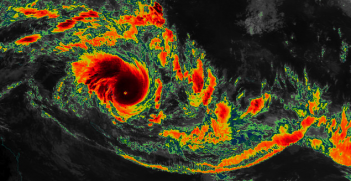The Boxing Day Tsunami: 10 Years On
Governments and NGOs need learn from the past to ensure that international response systems are truly fit for purpose.
Today marks ten years since the 2004 Boxing Day tsunami swept through coastal towns and cities surrounding the Indian Ocean, from Indonesia to the east coast of Africa, killing more than 220,000 people. It’s also ten years since I started my own career as an aid worker, in the worst-affected province of Aceh, Indonesia, where almost 170,000 people were killed.
A lot has changed in the international humanitarian response system in that time, but there are three changes in particular that I want to reflect upon. The first is the reduced availability of international funds as a proportion of rising humanitarian needs; the second, our increased recognition of the importance of supporting local response capacities; and the third, the changed role of national governments in disaster response.
On the funding side: one of the striking features of the tsunami response was the extraordinary scale of public and private donations. One month into the response, US$200m had been committed and well over US$2bn pledged. In the UK, an astonishing £10m was donated through the Disasters and Emergencies Committee’s website in just 24 hours. One year on, US$14bn had been raised, and aid agencies were reporting that the funds had exceeded ‘absorption capacity’. If the donations had been shared equally across all of those affected, each person would have received US$7,000, the largest amount ever raised per person in a disaster response.
We’ve not seen anything like it since, and it’s worth reflecting on because it serves as a reminder of the generosity that we – as individuals, as well as our governments – are capable of when we’re sufficiently moved. But we’re not always so moved, and as the frequency and intensity of climate-related disasters increases, governments’ humanitarian aid budgets are becoming more and more stretched, and competition for public attention is stiff. While global humanitarian assistance to UN appeals has increased over the past decade, it’s not kept pace with rising need.
Total humanitarian needs (at least, as measured by UN appeals) almost quadrupled between 2004 and 2013, from US$3.5bn to US$13.2bn. Unmet humanitarian needs rose almost at the same rate, from US$1.3bn to US$4.6bn. A quick scan of funding for recent major disasters shows a ‘per person’ amount that pales in comparison to the extraordinary tsunami response. Typhoon Haiyan in the Philippines last year, to provide just one example, affected 14 million people and attracted just US$38.7m in international funds – less than US$3 per person affected.
One of the implications of this rising need has been that we’ve had to figure out how to do more with less – or at least, with less international funds. And while there’s a lot of work still to be done, to some extent it’s led to smarter aid. ‘Innovation’ is the new buzz word, and we’re paying much more attention to what’s being done by affected communities and local and national governments, and how we can use resources as efficiently as possible to support them.
In the weeks and months following the tsunami, one of the things that struck me most profoundly was the capacity of people who had lost everything, in circumstances that we cannot even begin to imagine, to pick themselves up and piece together the shattered remnants of their lives. It’s these people who are the first responders. Then come local and national governments, sometimes national militaries, and only after that do international actors step in. In the tsunami response, there was little appreciation of this.
I have a memory from Aceh, a couple of months after the tsunami, of speaking to a child who said he’d been washing his clothes in the ocean as the tsunami approached. He watched as the wave came in, knowing that he would not survive. But the wave carried him two kilometres inland, finally dumping him like seaweed at the point where the wave turned and withdrew, leaving him the only surviving member of his family. When I spoke with him he’d been gathering material from the rubble that was once his neighbourhood, constructing a small shelter where his home once stood, oblivious to the efforts being made by so many different actors (my NGO included) to plan for his recovery.
While international actors were busy attending coordination meetings, discussing common approaches to ‘community driven development’ and writing proposals and strategies, in the affected communities, people were getting on with things. They were scrounging materials from the rubble that lay around them, and rebuilding homes, fishing boats, shops and businesses. And despite the billions of dollars flowing in, for the most part they were doing so without any sort of assistance, because this assistance was moving slowly through the planning and approval process.
We’ve a much better appreciation now of communities as the first responders, but we have a long way to go to adapt our sophisticated international systems properly to support this first and most important stage of the response.
The other very important change since the tsunami is that national governments have stepped up to take a much stronger role in managing the response. In Aceh in 2005, upwards of 300 international NGOs and 2,000 international aid workers descended upon the province, with little regard (at least in the early stages) for the role of the Indonesian government. A decade on, all Asian governments now have their own disaster management organisations and some form of legislative or regulatory framework. Having witnessed the response to the tsunami, they understandably wish to avoid another ‘free for all’ in which hundreds of international agencies of varying credentials compete for space with limited government oversight. They are asserting their capacity and entitlement to manage their own disasters, albeit with assistance from selected donors based on bilateral agreements and on their own terms. It’s entirely appropriate, and it’s the way forward, but it’s a challenge for an international system that is more or less set up on the assumption that international actors will take the lead.
We have come a long way over the past decade, but with disaster risk increasing, and an increasing need to do more with less, we have a lot of work to do to ensure that our international response systems are truly fit for purpose in the coming years. That is, that they are adapted to assist as many people as possible with limited funds, and to provide local communities and governments with the support they need to manage the response.
Rebecca Barber is a Humanitarian Policy & Advocacy Advisor for Save the Children Australia.





